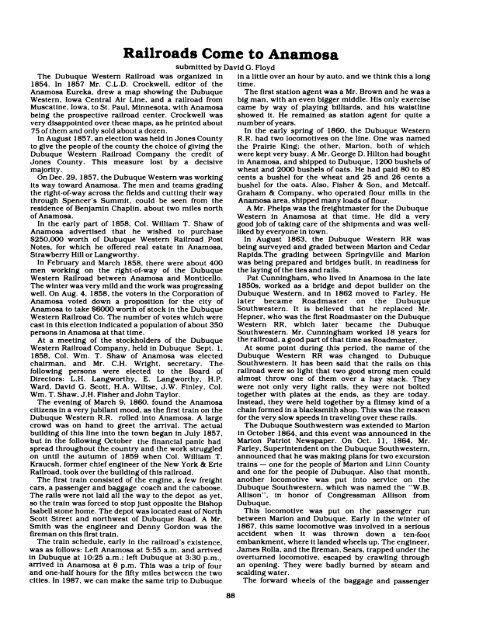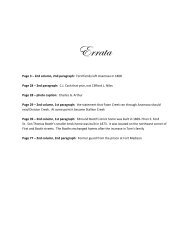Anamosa - A Reminiscence 1838 - 1988
The definitive history of the community of Anamosa, Iowa, USA
The definitive history of the community of Anamosa, Iowa, USA
You also want an ePaper? Increase the reach of your titles
YUMPU automatically turns print PDFs into web optimized ePapers that Google loves.
Railroads Come to <strong>Anamosa</strong><br />
submitted by David G. Floyd<br />
The Dubuque Western Railroad was organized in<br />
1854. In 1857 Mr. C.L.D. Crockwell, editor of the<br />
<strong>Anamosa</strong> Eureka, drew a map showing the Dubuque<br />
Western, Iowa Central Air Line, and a railroad from<br />
Muscatine. Iowa. to St. Paul. Minnesota, with <strong>Anamosa</strong><br />
being the prospective railroad center. Crockwell was<br />
very disappointed over these maps. as he printed about<br />
75 of them and only sold about a dozen.<br />
In August 1857, an election was held in Jones County<br />
to give the people of the county the choice of giving the<br />
Dubuque Western Railroad Company the credit of<br />
Jones County. This measure lost by a decisive<br />
majority.<br />
On Dec. 29. 1857, the Dubuque Western was working<br />
its way toward <strong>Anamosa</strong>. The men and teams grading<br />
the right-of-way across the fields and cutting their way<br />
through Spencer's Summit, could be seen from the<br />
residence of Benjamin Chaplin. about two miles north<br />
of <strong>Anamosa</strong>.<br />
In the early part of 1858, Col. William T. Shaw of<br />
<strong>Anamosa</strong> advertised that he wished to purchase<br />
$250,000 worth of Dubuque Western Railroad Post<br />
Notes, for which he offered real estate in <strong>Anamosa</strong>.<br />
Strawberry I-lill or Langworthy.<br />
In February and March 1858, there were about 400<br />
men working on the right-of-way of the Dubuque<br />
Western Railroad between <strong>Anamosa</strong> and Monticello.<br />
The winter was very mild and the work was progressing<br />
well. On Aug. 4, 1858, the voters in the Corporation of<br />
<strong>Anamosa</strong> voted down a proposition for the city of<br />
<strong>Anamosa</strong> to take $6000 worth of stock in the Dubuque<br />
Western Railroad Co. The number of votes which were<br />
cast in this election indicated a population of about 350<br />
persons in <strong>Anamosa</strong> at that time.<br />
At a meeting of the stockholders of the Dubuque<br />
Western Railroad Company, held in Dubuque Sept. 1,<br />
1858. Col. Wm. T. Shaw of <strong>Anamosa</strong> was elected<br />
chairman. and Mr. C.H. Wright. secretary. Thefollowing<br />
persons were elected to the Board of<br />
Directors: L.H. Langworthy. E. Langworthy. H.P.<br />
Ward. David G. Scott. H.A. Wiltse, J.W. Finley. Col.<br />
Wm. T. Shaw, J .I-I. Fisher and John Taylor.<br />
The evening of March 9, 1860, found the <strong>Anamosa</strong><br />
citizens in a very jubilant mood, as the first train on the<br />
Dubuque Western R.R. rolled into <strong>Anamosa</strong>. A large<br />
crowd was on hand to greet the an'ival. The actual<br />
building of this line into the town began in July 1857,<br />
but in the following October the financial panic had<br />
spread throughout the country and the work struggled<br />
on until the autumn of 1859 when Col. William T.<br />
Kraucsh, former chief engineer of the New York 8: Erie<br />
Railroad. took over the building of this railroad.<br />
The first train consisted of the engine, a few freight<br />
cars. a passenger and baggage coach and the caboose.<br />
The rails were not laid all the way to the depot as yet.<br />
so the train was forced to stop just opposite the Bishop<br />
lsabell stone home. The depot was located east of North<br />
Scott Street and northwest of Dubuque Road. A Mr.<br />
Smith was the engineer and Denny Gordon was the<br />
fireman on this first train.<br />
The train schedule, early in the railroad's existence,<br />
was as follows: Left <strong>Anamosa</strong> at 5:55 a.m. and arrived<br />
in Dubuque at 10:25 a.m.: left Dubuque at 3:30 p.m.,<br />
arrived in <strong>Anamosa</strong> at 8 p.m. This was a trip of four<br />
and one-half hours for the fifty miles between the two<br />
cities. In 1987, we can make the same trip to Dubuque<br />
in a little over an hour by auto, and we think this a long<br />
time.<br />
The first station agent was a Mr. Brown and he was a<br />
big man, with an even bigger middle. His only exercise<br />
came by way of playing billiards, and his waistline<br />
showed it. He remained as station agent for quite a<br />
number of years.<br />
In the early spring of 1860, the Dubuque Western<br />
R.R. had two locomotives on the line. One was named<br />
the Prairie King; the other, Marion, both of which<br />
were kept very busy. A Mr. George D. Hilton had bought<br />
in <strong>Anamosa</strong>, and shipped to Dubuque, 1200 bushels of<br />
wheat and 2000 bushels of oats. He had paid 80 to 85<br />
cents a bushel for the wheat and 25 and 26 cents a<br />
bushel for the oats. Also, Fisher 8: Son. and Metcalf.<br />
Graham 8: Company. who operated flour mills in the<br />
<strong>Anamosa</strong> area, shipped many loads of llour.<br />
A Mr. Phelps was the freightmaster for the Dubuque<br />
Western in <strong>Anamosa</strong> at that time. He did a very<br />
good job of taking care of the shipments and was wellliked<br />
by everyone in town.<br />
In August 1863, the Dubuque Western RR was<br />
being surveyed and graded between Marion and Cedar<br />
Rapids.The grading between Springville and Marion<br />
was being prepared and bridges built. in readiness for<br />
the laying of the ties and rails.<br />
Pat Cunningham, who lived in <strong>Anamosa</strong> in the late<br />
1850s, worked as a bridge and depot builder on the<br />
Dubuque Western, and in 1862 moved to Farley, He<br />
later became Roadmaster on the Dubuque<br />
Southwestern. It is believed that he replaced Mr.<br />
Hepner, who was the first Roadmaster on the Dubuque<br />
Western RR, which later became the Dubuque<br />
Southwestern. Mr. Cunningham worked 18 years for<br />
the railroad, a good part of that time as Roadmaster.<br />
At some point during this period. the name of the<br />
Dubuque Western RR was changed to Dubuque<br />
Southwestern. It has been said that the rails on this<br />
railroad were so light that two good strong men could<br />
almost throw one of them over a hay stack. They<br />
were not only very light rails. they were not bolted<br />
together with plates at the ends, as they are today.<br />
Instead, they were held together by a flimsy kind of a<br />
chain formed in a blacksmith shop. This was the reason<br />
for the very slow speeds in traveling over these rails.<br />
The Dubuque Southwestem was extended to Marion<br />
in October 1864, and this event was announced in the<br />
Marion Patriot Newspaper. On Oct. 11, 1864. Mr.<br />
Farley. Superintendent on the Dubuque Southwestern.<br />
announced that he was making plans for two excursion<br />
trains — one for the people of Marion and Linn County<br />
and one for the people of Dubuque. Also that month.<br />
another locomotive was put into service on the<br />
Dubuque Southwestern, which was named the "W.B.<br />
Allison", in honor of Congressman Allison from<br />
Dubuque.<br />
This locomotive was put on the passenger run<br />
between Marion and Dubuque. Early in the winter of<br />
1867. this same locomotive was involved in a serious<br />
accident when it was thrown down a ten-foot<br />
embankment, where it landed wheels up. The engineer,<br />
James Rolla, and the fireman. Sears. trapped under the<br />
overturned locomotive, escaped by crawling through<br />
an opening. They were badly burned by steam and<br />
scalding water.<br />
The forward wheels of the baggage and passenger



